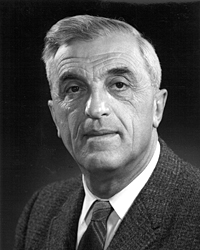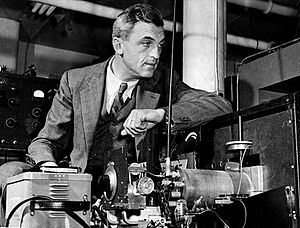Felix Bloch facts for kids
Quick facts for kids
Felix Bloch
|
|
|---|---|

Bloch in 1952
|
|
| Born | 23 October 1905 |
| Died | 10 September 1983 (aged 77) |
| Nationality | Swiss |
| Citizenship |
|
| Alma mater |
|
| Known for |
|
| Awards | Pour le Mérite for Sciences and Arts (1979) Fritz London Memorial Lecture (1959) Guggenheim Fellowship (1959) Nobel Prize for Physics (1952) |
| Scientific career | |
| Fields | Physics |
| Institutions | |
| Doctoral advisor | Werner Heisenberg |
| Doctoral students | Carson D. Jeffries |
Felix Bloch (born October 23, 1905 – died September 10, 1983) was a Swiss-American physicist. He won the Nobel Prize for Physics in 1952. He shared the award with Edward Mills Purcell. They were honored for finding new ways to measure magnetism in atomic nuclei. From 1954 to 1955, Bloch was the first Director-General of CERN. CERN is a famous research organization in Europe. Felix Bloch also helped us understand how magnets work and how electrons behave in materials. He is known as one of the people who developed nuclear magnetic resonance.
Contents
About Felix Bloch
Early Life and School
Felix Bloch was born in Zürich, Switzerland. His parents were Gustav and Agnes Bloch. His father, Gustav, worked as a grain dealer. He moved to Zürich from Moravia in 1890. Felix had an older sister, born in 1902.
Felix started elementary school when he was six. He sometimes felt different from other kids. His older sister helped him a lot. Sadly, she passed away when she was twelve. This made Felix very sad for a while.
He started playing the piano at age eight. He also loved arithmetic because it was clear and beautiful. At twelve, he went to a secondary school called the Cantonal Gymnasium in Zürich. He studied there to get ready for university.
When he was fifteen, Felix also began studying at the Eidgenössische Technische Hochschule (ETHZ). He first studied engineering but soon switched to physics. He learned from famous scientists like Peter Debye and Erwin Schrödinger. Another student in his classes was John von Neumann.
University Studies
Felix Bloch graduated from ETH Zürich in 1927. His professor, Peter Debye, told him to study with Werner Heisenberg in Leipzig. Heisenberg was a very important physicist.
Bloch became Heisenberg's first student working on a doctorate degree. He earned his doctorate in 1928. His main project was about how tiny particles called electrons move in solid materials. He used a new idea called quantum theory to explain it.
Family Life
On March 14, 1940, Felix Bloch married Lore Clara Misch. She was also a physicist. They met at a science meeting. They had four children together. Their twin sons, George and Daniel, were born in 1941. Their son Frank was born in 1945, and their daughter Ruth was born in 1949.
His Career in Physics
After finishing his studies, Bloch worked with many famous scientists in Europe. He studied how some materials become superconductors with Wolfgang Pauli in Zürich. He also worked with Heisenberg on ferromagnetism, which is about how magnets work. He described "Bloch walls", which are boundaries inside magnetic materials. He also suggested the idea of spin waves, which are like tiny waves in magnetic structures.
Bloch also worked with Niels Bohr in Copenhagen. There, he studied how charged particles slow down when they travel through matter. He also worked with Enrico Fermi in Rome.
In 1932, Bloch became a lecturer in Leipzig. But in 1933, when Hitler came to power, Bloch left Germany because he was Jewish. He went back to Zürich and then lectured in Paris.
Moving to the United States
In 1934, Stanford University invited Bloch to join their physics department. Bloch accepted and moved to the United States. In 1938, he started working at the University of California, Berkeley. He studied the magnetic properties of neutrons there. Neutrons are tiny particles inside atoms.
Bloch became the first professor of theoretical physics at Stanford. In 1939, he became a citizen of the United States.
During World War II, Bloch briefly worked on the Manhattan Project. This project was about building the atomic bomb. However, he didn't like the military style of the lab. He was also not very interested in the theoretical work there. So, he left and joined a project working on radar at Harvard University.
Nobel Prize and CERN
After the war, Bloch focused on studying nuclear induction and nuclear magnetic resonance (NMR). These ideas are very important for MRI, which doctors use to see inside the body. In 1946, he created the Bloch equations. These equations explain how the magnetism in atomic nuclei changes over time.
In 1948, he became a member of the United States National Academy of Sciences. In 1952, Felix Bloch and Edward Mills Purcell won the Nobel Prize in Physics for their work on nuclear magnetic induction.
In the early 1950s, a new international science center called CERN was being built. The founders wanted a respected scientist to lead it. In 1954, Professor Bloch became CERN's first Director-General. He helped start the construction of the main site and plan for the first big machines.
After leaving CERN, he went back to Stanford University. In 1961, he became the Max Stein Professor of Physics there. He was also a member of several important science groups.
Felix Bloch passed away in Zürich in 1983.
See also
 In Spanish: Felix Bloch para niños
In Spanish: Felix Bloch para niños
- List of Jewish Nobel laureates
- List of things named after Felix Bloch


